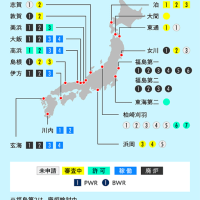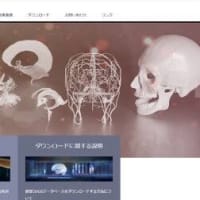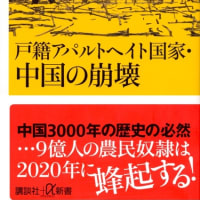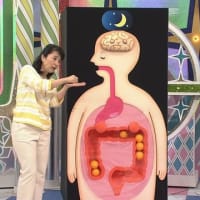__________________________
Two years later, in 2009, Jacob and colleagues analyzed the 15 countries’ study we’ve just reviewed, plus eight other nuclear workers studies. What makes nuclear worker exposures especially relevant to areas contaminated by nuclear fallout is its dose exposure scenarios to deliver doses at a slow, persistent rate.
And the meta analysis of Jacob and colleagues suggests that such slow-dose rates might be more harmful than fast-dose rates.
その2年後の2009年に、ジェイコブとその同僚研究者が、この動画で今みたばかりの15ヶ国調査研究に加え、他の8つの原子力関連労働者調査研究を分析した。原子力産業労働者の被ばくを放射性降下物によって汚染された地域に特に関連づけるものが、その分析による、持続的な低線量による被ばくシナリオである。
そしてジェイコブたちのメタ解析は、そのような低線量が高線量よりもずっと有害かもしれないということを示す。
For example, this chart from Jacob et al shows excess cancer mortality risk found in nine studies of nuclear workers. Each study it noted, by a red dot whose rightward displacement from zero risk along the bottom axis to note to the degree of increased risk found in that study. In contrast, the blue dots represent comparative excess risks among the atom-bomb survivor cohort.
Adjusted to match to the sex ratio and the average age of nuclear workers in each study, as we can see, the red dots are usually more rightward displaced than the blue dots, and therefore, most nuclear worker studies found higher risk of cancer mortality than among atom-bomb survivors.
たとえば、ジェイコブたちが示したこのチャートは、原子力産業労働者に対する9つの調査研究でわかった過剰ガン死のリスクを示す。一つずつの調査で見つかったリスク増大の度合いは、一番下の軸上のリスクゼロの地点からどれくらい右寄りに赤い点が離れているかで示される。これとは対照的に、青い点は原爆生存者集団の間に見られた比較上の過剰リスクを表す。
それぞれの研究において、原子力関連労働者の男女比と平均年齢を合わせるように調整すると、赤い点は大抵、青い点より右よりに位置し、それゆえ、ほとんどの原子力関連労働者研究で原爆生存者の調査よりも高いガン死のリスクが見つかったのだ。
This is a significant finding because radiation risk models are largely founded upon fast-dose exposures like from atomic-bomb blasts, and it has been assumed that fast-dose rates were more harmful. However, the findings of Jacob and colleagues bring us a few in the question, as an editorial on the findings of Jacob et al, in the journal Occupation and Environmental Medicine observed: “ …a number of recent studies challenge the assumption that low-dose-rate exposures to penetrating forms of ionizing radiation are less effective at causing cancer than high-dose-rate exposures, because risk estimates for people who received low-dose-rate exposures tend to be larger than, or similar to, the corresponding estimates derived from the study of Japanese atomic-bomb survivors. “
これは重要な発見である、なぜなら放射線リスクモデルはほとんどが原爆の爆発からのような、高線量被ばくに基づいているからであり、高線量はより有害であるとこれまで仮定されていたからだ。しかしながら、ジェイコブたちの発見には数カ所疑問点がある、オキュペイション・アンド・エンヴァイロンメンタル・メディスン誌がジェイコブたちの調査結果に対する次のような論説を掲載したように:「…最近の幾つかの調査研究は、透過力のある電離性放射能への低線量被ばくは、高線量被ばくよりもガンを発症させる影響は低いという想定に挑んでいる、なぜなら低レベル被ばくした人びとへのリスク評価が、日本の原爆生存者調査に由来する対応評価よりも大きいか、それと類似する傾向があるからだ。」
This graph of Jacob et al. demonstrates the discrepancy of risk models. The two leading risk models are on the left. The second is the National Academy of Sciences’ cancer risk model we examined previously. Both risk models are based largely on the fast-dose-rate exposures experienced by atomic-bomb survivors. But the third bar on the right represents the higher level of risk derived from slow-dose-rate experienced by nuclear workers. So the cutting-edge of meta analytical research suggests that the leading contemporary radiation risk models may actually underestimate the carcinogenic efficiency of low-dose radiation.
ジェイコブたちのこのグラフは、リスクモデルの矛盾を例証する。主要なリスクモデルは左側の二つである。左から2番目が、我々が今見た全米科学アカデミーのガンリスクのモデルだ。どちらのリスクモデルともおおよそ、原爆生存者が受けた高線量被ばくを基本にしている。しかし一番右の棒グラフは、原子力関連労働者が受ける低線量被ばくから生じるリスクが、それら二つより高いことを示している。ゆえに最新のメタ分析リサーチは、主流の放射線リスクモデルが、低線量の発がん効果を実際には過小評価しているかもしれないことを示唆する。
_________________________
Science is not only further clarifying the harmful effects of low-dose radiation on large-scale, macroscopic levels but on a microscopic level as well. Recent research has increased the fatality of data in the low-dose range regarding radiation-induced genetic damage. Chromosomal translocation are reform of genetic damage resulting from the faulty repair of DNA molecules damaged by genotoxic chemicals, or radiation.
科学は肉眼で見えるほどの大きな粒子レベルだけでなく、顕微鏡で見るほどのレベルについても、低線量放射線
による有害影響をさらに明確にしつつある。最近の研究は、放射線で誘発される遺伝子へのダメージについて、低線量の範囲内でのデータの死亡率を増大させた。染色体転移は、遺伝毒性化合物、すなわち放射能、により被害を受けたDNA分子の修正欠陥が原因で生じる遺伝子上のダメージである。
Chromosomal translocations, also known as chromosomal aberrations, are believed to result in many forms of cancer, and the increased frequency of chromosomal aberrations is recognized as an indication of increased risk of cancer. As such, radiation-induced chromosomal aberrations are fundamental to the cause or mechanism of radiation-induced cancer. It has been well-documented that a median to high-dose radiation increases chromosomal aberrations, but the influence of low-dose radiation has been less certain. But this mechanism of radiation-induced cancer occurs at low-doses. There would be little reason to doubt
that low-dose radiation can cause cancer.
染色体転移は、染色体異常という言葉でも知られるが、多くのガンにいたると信じられており、染色体異常の頻度増大は、ガンのリスク増大の指標として認識されている。そのようなものであるため、放射線が誘発した染色体異常は、放射線誘発によるガンの原因や仕組みにとって根源的なものである。中レベルから高レベルの放射線量が染色体異常を増大させることは、これまでに多くの研究発表が行われてきているが、低線量放射線の影響は、それほど定かではない。しかし放射線が誘発するガンの仕組みは、低線量で発生する。低線量放射線がガンを引き起こすことを疑う理由はほとんどないであろう。
_________________
In 2010, Bhatti and colleague published a meta analysis of studies that examined the influence of medical X-ray examinations on the incidence of chromosomal translocation.
2010年、Bhattiとその同僚が、染色体転移の症例に対する医療用X線検査の影響を解析した調査研究のメタ分析を発表した。
They sought to gain greater precision on the impact of low-dose radiation by pulling that from multiple studies. Not only did they find those responses in low-dose range, but to their surprise, the frequency of chromosomal aberrations per unit of radiation increased below approximately 20mSv. Moreover, at doses below approximately 10mSv, the frequency of aberrations per unit of radiation increased further still, and by an order of the magnitude.
彼らは、それまでの多数の研究から、低線量放射線を引き出すことで、その影響に関してより高い正確性を得ようとした。彼らは低線量の範囲における対応症例を見つけただけでなく、自分たちで驚いたことには、放射線の単位ごとの染色体異常の頻度がおよそ20mSv未満で増大することも見つけたのだ。さらに、ほぼ10mSv未満の線量で、放射線の単位毎の異常の頻度がさらに、それも桁違いに増大していた。
At lower dose ranges, the dose-response relationship became increasingly large and inconsistent with the overall estimate. AT dose scores of 20 and lower ( n=196), the magnitude of the association was 0.08 translocations/ 100 CE/10 dose score units ( 95% CI: -0.002, 0.02, P=0.1; Fig.2b). At dose scores of 10 and lower ( n=131), the estimate of the dose-response relationship was 0.3 excess translocations/100 CE/ 10 dose score units (95%CI: 0.06, 0.5, P=0.02) (Fib.2c). ( dose score of 10= aaprox.10mSv)
※ 低線量範囲になるほど、線量-反応関係が強まり、全体の評価との不一致が明らかになった。線量スコアが20ユニット以下で (n=196)、線量-反応関係を表す転座頻度 は転座数0.08/100細胞等量/10ユニット (n=131) であった ( 95% CI: -0.002, 0.02, P=0.1; Fig.2b)。線量スコア10ユニット以下で、線量-反応関係を表す転座頻度の推定値は、転座数0.3/100細胞等量/10ユニットを超えた。(Fib.2c).
( 線量スコア10ユニット= 約10mSv)
_________________
Given these findings, evidence for the carcinogenicity of radiation at low-doses could hardly be more logically indicated as this examined formally.
The hypothetical syllogism is its two premises’ argument schema of classical logic of the form. Given that,
if it’s the case the P, then, Q. And, if it’s the case the Q, then, R. Then we may conclude that it is also the case that if P, then R. Plugging the scientific evidence we’ve just reviewed into the hypothetical syllogism, we may reason as follows.
Given that, if there is low-dose radiation, and then there’s more chromosomal harm. And
If there’s more chromosomal harm, then, there’s more cancer. Then, we may conclude, if there is low-dose radiation, then there’s more cancer.
これら分かったことを考えれば、低線量での放射線の発がん性を示す証拠は公式に検査されたこの調査解析であることを、これ以上論理的に示すことはほとんど不可能であろう。
仮言三段論法が、その二つの前提の古典的な型枠論理の議論スキーマである。
仮にPであるならば、Qであるとし、そしてQであるならばRとする。そうすると、PであるならばRという場合もあると結論できるわけだ。
我々がいま見てきた科学的な実証を、この仮言三段論法に当てはめれば、次のように推論できよう。
低線量放射線がある場合に、染色体異常の増加があるとする。染色体異常の増加がある場合にガンの増大があるとする。そうであるなら、低線量放射線があればガンが増大すると結論できるかもしれない。
To some degree, this syllogism may be oversimplification. However, our inputs in this borrowed argument schema are the output of state-of-the-art biological research.
この三段論法はやや単純すぎるだろう。しかしながら、三段論法から借用した議論スキーマに我々が当てはめたものが、最新の生物学研究の結果である。
In this video, we both reviewed both established radiobiology and recent radiobiological research. From this broad scientific base, we’ve observed that the National Academy of Sciences predicts increased cancer risk from exposures below 20mSv/year. Research published since the Academy’s last report in 2006 corroborates that prediction. Recent research also suggests that the Academy’s risk models may underestimate cancer risk. Recent research also finds that radiation exposures below 20mSv are associated with genetic damage.
このビデオで、我々はすでに確立された放射線生物学と、最近の放射線生物学研究の両方を再検討した。この広範な科学的な土台から、我々は米国の全米科学アカデミーが、年20mSv未満の被ばくからガンリスクが増大すると予見していることを求めた。2006年に出た同アカデミーの最新の報告以来、今日まで発表された調査研究はその予見を裏付けている。最近の研究はまた、同アカデミーのリスクモデルがガンのリスクを過小評価しているかもしれないことを示唆してもいる。最近の研究はさらに、20mSv未満の放射線被ばくが遺伝子損傷に関連があることを見つけている。
Therefore, both historical and cutting-edge scientific research consistently demonstrate that Japan’s allowance of 20mSv/year is not safe.
それゆえ、従来のもの、最新の科学調査研究、そのどちらも、日本による年20mSvの放射線許容基準が安全ではないことを一貫して論証している。




















※コメント投稿者のブログIDはブログ作成者のみに通知されます